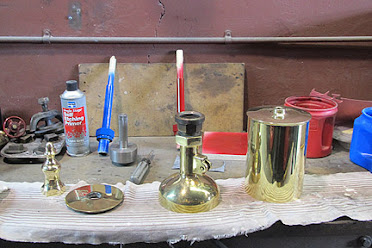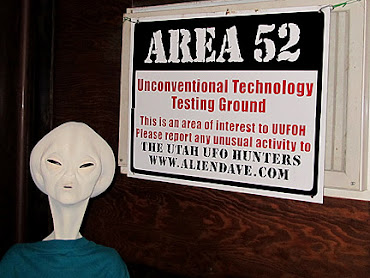On my way to the spot where the first transcontinental railroad was born when the Central Pacific Railroad met the Union Pacific Railroad, I found this display:
There were several photos with the story of this small town.
Tinky Winky takes a ride with the muleskinner.
What the display didn't tell me: In its hayday (1869), Corinni was known as the "Gentile Capital of Utah" with over a thousand permanent residents, not one of whom was Mormon. By 1877 when the railroad lines were changed, the Gentile merchants abandoned Corinne for Ogden and the Mormon farmers moved in. This is the only original building still standing:
As I got closer to my destination, I saw signs saying "Rocket Display," so I made a 2 mile detour to check it out:
TW takes a ride on a TX-38 SPAM ducted rocket.
Signage: Frontiers of Transportation – Here you stand on one of the great frontiers of transportation history in North America. In 1841, the route of the first emigrant train to reach California overland climbed the mountain pass to your left. And the Oregon trail passed just 80 miles to the north. Ahead, just over the Promontory Mountains, two hotly competing railroad companies, the Union Pacific coming west from Nebraska, and the Central Pacific working east from California, joined their rails on May 10, 1869, completing the world’s first transcontinental railroad. The United States remains a nation on the move. Today’s technological frontier has been lifted skyward by the Thiokol Corporation, which builds and test rockets here in northern Utah to support America’s space and defense programs.
Golden Spike National Historic Site:
Titled “East and West Shaking Hands at Laying of Last Rail” and taken by Andrew J. Russell; this is the most famous photograph associated with the completion of the first transcontinental railroad. Commonly called “The Champagne Photo,” it is one of the most recognized images, known world-wide:
Reenactments are held on Saturdays and holidays from May to Labor day using exact replicas of the original trains. You can see then here: Link to: Golden Spike 150th Celebration
This being winter the engines are in the shop being refurbished.
In 1868, Schenectady Locomotive Works in New York build the Jupiter for the Central Pacific Railroad.
Steaming her way into history, the Jupiter hauled CPR President Leland Stanford’s special train to Promontory Summit for the joining of the rails.
The Jupiter remained in service until the turn of the 20th century when, outmoded and unheralded, she was scrapped for the standard fee of $1,000. In November of 1868, Rogers Locomotive and Machine Works of Paterson, New Jersey built the Union Pacific No. 119.
Six months later, No. 119 received the call to pull Union Pacific Vice-President Thomas Durant and his contingent to Promontory Summit.
The No. 119 served out her days with the Union Pacific as a freight locomotive until dismantled in 1903 for the standard scrapper’s fee for $1,000.
Charged with producing replicas virtually identical to the original engines, O’Connor Engineering Laboratories of Costa Mesa, California did just that, down to the last decorative detail.
For safety reasons, the replica engines differ from the originals in three ways: Cylinder design, Boiler assembly and Breaking system.
Besides the mechanical service, all the brass is removed and hand-polished. Above is a whistle.
I had no idea the pilot (cowcatcher) was made of wood.
Monument placed in 1916, transferred to the National Park Service in 1965, fully restored and moved to current location in 2001.
One of the two ceremonial golden spikes is currently under glass at the Stanford University Museum.
A record that was never broken.Of the four thousand laborers, one tenth was Irish and the rest Chinese. According to the Chinese Historical Society of America (Link to: CPR Photographic History Museum) between 100-150 Chinese workers lost their lives working on the CPRR, not the thousands that were incorrectly reported in newspapers of the era.
The crossing sign says “LOOK OUT FOR LOCOMOTIVE.”





















































